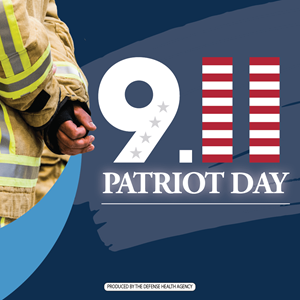Skip subpage navigation
 The Defense Health Agency commemorates the 20th anniversary of the attacks on September 11, 2001—a searing moment in American history that remains all too vivid for many today. Not only were military medical personnel critical in treating and saving lives of victims of the attack on the Pentagon, but our military medical forces also responded to ground zero in New York. Many of the medical heroes of 9/11 continue to serve their country and patients, even 20 years later.
The Defense Health Agency commemorates the 20th anniversary of the attacks on September 11, 2001—a searing moment in American history that remains all too vivid for many today. Not only were military medical personnel critical in treating and saving lives of victims of the attack on the Pentagon, but our military medical forces also responded to ground zero in New York. Many of the medical heroes of 9/11 continue to serve their country and patients, even 20 years later.
Delivering deployed medical support and combat medicine in the 20 years since the 9/11 attacks has revolutionized many fields of military medicine. We want to recognize advances in the MHS since 9/11, and highlight how military medicine contributes to medical practice. Medical advances since 9/11 continue to improve care for service members, dependents and retirees, help service members recover from illness and injury, and save lives in our local communities.
You also may be interested in...
Article
Sep 15, 2023
The Defense Health Agency marked the 22nd anniversary of 9/11 with a remembrance ceremony at Defense Health Headquarters in Falls Church, Virginia, on Sept. 11, 2023.
Article
Sep 13, 2022
Telling our stories is an important way to remember and honor the fallen on that day.
Article
Sep 14, 2021
Military Health System leaders recall their 9/11 stories.
Article
Sep 14, 2021
Years of military conflict in Iraq and Afghanistan brought innovations that completely transformed the Military Health System's approach to combat casualty care. Here's a list of just a few ways military medicine has evolved in the two decades since the 9/11 attacks.
Article
Sep 10, 2021
A Defense Health Agency IT specialist recalls his 9/11 experience.
Article
Sep 10, 2021
Vivid memories and somber reflections marked an emotional ceremony at Defense Health Agency headquarters on Friday as the military medical community remembered and honored the victims of the terrorist attacks of Sept. 11, 2001.
Article
Sep 15, 2016
Jessica Meyle, a current employee at the Defense Health Agency recalls events on 9/11 and the day after.
Article
Sep 14, 2016
Army Col. (Dr.) Geoffrey G. Grammer recalls the events of 9/11
Article
Sep 14, 2016
Kate McGraw recalls the events of 9/11 at Dover Air Force Base, Delaware
Article
Sep 13, 2016
Paul K. Carlton Jr. recalls the events of 9/11
Publication
Sep 12, 2016
 .PDF |
2.95 MB
.PDF |
2.95 MB
USU graduates, faculty and students were among the first responders to New York and Washington, as well as the Pennsylvania crash site. Their extensive training and experience enabled them to react and mobilize quickly, many of them within seconds of the Pentagon attack.
Article
Sep 12, 2016
Patricia Horoho and Malcolm Nance recall the events of 9/11
Article
Sep 12, 2016
Former U.S. Army Surgeon General recalls the events of 9/11 at the Pentagon
Photo
Sep 11, 2016
A fire fighter from Arlington County, Fire Department surveys the scene during rescue and recovery efforts following the deadly Sep. 11 terrorist attack in which a hijacked commercial airliner was crashed into the Pentagon. American Airlines FLT 77 was bound for Los Angeles from Washington Dulles with 58 passengers and 6 crew. All aboard the aircraft ...
Photo
Sep 11, 2016
Military Service members render honors as fire and rescue workers unfurl a huge American flag over the side of the Pentagon during rescue and recovery efforts following the Sept 11 terrorist attack. The attack came at approximately 9:40 a.m. as a hijacked commercial airliner, originating from Washington D.C.'s Dulles airport, was flown into the ...
You are leaving Health.mil
The appearance of hyperlinks does not constitute endorsement by the Department of Defense of non-U.S. Government sites or the information, products, or services contained therein. Although the Defense Health Agency may or may not use these sites as additional distribution channels for Department of Defense information, it does not exercise editorial control over all of the information that you may find at these locations. Such links are provided consistent with the stated purpose of this website.
You are leaving Health.mil
View the external links disclaimer.
Last Updated: July 11, 2023